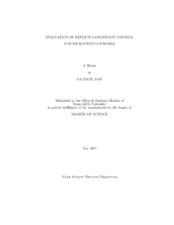| dc.description.abstract | Recently, there has been a significant surge of interest towards the design and
development of a new global-scale communication network that can overcome the
limitations of the current Internet. Among the numerous directions of improvement
in networking technology, recent pursuit to do better flow control of network traffic
has led to the emergence of several explicit-feedback congestion control methods. As a
first step towards understanding these methods, we analyze the stability and transient
performance of Rate Control Protocol (RCP).We find that RCP can become unstable
in certain topologies and may exhibit very high buffering requirements at routers. To
address these limitations, we propose a new controller called Proportional Integral
Queue Independent RCP (PIQI-RCP), prove its stability under heterogeneous delay,
and use simulations to show that the new method has significantly lower transient
queue lengths, better transient dynamics, and tractable stability properties.
As a second step in understanding explicit congestion control, we experimentally
evaluate proposed methods such as XCP, JetMax, RCP, and PIQI-RCP using their
Linux implementation developed by us. Our experiments show that these protocols
are scalable with the increase in link capacity and round-trip propagation delay. In
steady-state, they have low queuing delay and almost zero packet-loss rate. We
confirm that XCP cannot achieve max-min fairness in certain topologies. We find that JetMax significantly drops link utilization in the presence of short flows with long flow
and RCP requires large buffer size at bottleneck routers to prevent transient packet
losses and is slower in convergence to steady-state as compared to other methods. We
observe that PIQI-RCP performs better than RCP in most of the experiments. | en |


